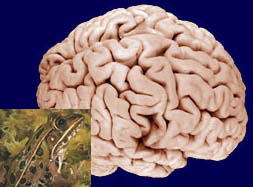
Biology 202
Neurobiology and Behavior
Spring 2004


| Biology 202 | 
|
Website: http://serendipstudio.org/bb/neuro/neuro04
Prospectus: The objective of this course is to introduce you to the prospects and problems of trying to understand behavior in terms of nervous system function, and to involve you in ongoing thinking along these lines. It is a comprehensive treatment neither of research on the nervous system nor of that on behavior, but rather a consideration of the relations between the two. As such, it is largely a course on how to identify and investigate problems, rather than one intended to convey a predefined body of information, and may be of interest to students expecting to do more advanced work in any of a variety of fields. It is also a course that requires a serious, active, and continuing engagement from students, regular attendence, and and a resonable amount of self-motivation outside of class. Lecture/discussions will provide you with useful observational and conceptual foundations from which you can proceed to explore interests of your own that you in turn will share with others. You will do so by additional readings, discussion, and writing based on your own interests.
Organization: The class will meet twice a week for lecture/discussions as shown on the accompanying Course Schedule. In addition to active participation in those sessions, students will spend additional time on reading as well as on preparation of weekly forum postings and of three longer papers (see below). You should expect to average six hours a week on this course, over and above class time. The three longer papers will replace examinations in this course. They, and the shorter forum postings, are intended to involve you as participants, as simultaneously both students and teachers, in a collective discussion of issues of brain and behavior, and will be made available to others on line. You will thus, to be an effective participant in this course, need to be able and willing to be part of a public conversation. I will be happy to meet individually with students at mutually convenient times, easily easily arranged by email or by checking with me before or after class sessions, to talk further about the objectives of the course and matters that arise during it.
Readings: A cardinal principle of this course is that material is best mastered by becoming actively involved with it, by beginning with questions/interest of your own, by looking at them from a variety of points of view, and by using each to critically weigh the usefulness of others. Readings are an important source of these additional points of view. There is no required text for this course. You should, however, plan to spend two to three hours a week on related readings. Suggestions for particular online readings relevant to material being discussed each week will be made in class, but you should yourself be exploring available resources for materials that match your interests and background.
Articles in Scientific American are generally written at a level of accessibility comparable to the aspirations of this course. Older articles organized in relation to sections of the course are included in a list of Scientific American articles, which are on reserve in Collier Library. The list includes as well more recent articles, some available online. Recent issues of Scientific American, the journal Trends in Neuroscience, and Annual Reviews of Neuroscience (all available in Collier Library) are good starting places for further reading on many aspects of neurobiology and behavior. So too are occasional articles appearing in the Science Times section of the New York Times (Tuesdays) and in the New York Review of Books. Students wanting more details on basic cellular processes or relevant aspects of the vertebrate nervous system may wish to spend some time with Kandel, Schwartz, and Jessel, Principles of Neural Science, which is on reserve in the Collier Library.
A number of quite good books on various aspects of neurobiology and behavior, written at levels appropriate for this course, have appeared in recent years (and continue to appear). These are a source of additional useful perspectives. A Course Evolving Book list is available from the course home page. With permission of the instructor a review of one such book can be substituted for one of the first two web papers required for this course.
The World Wide Web is an increasingly important, accessible, large, and constantly evolving set of resources which can be conveniently explored beginning at the course website. This material will be extensively used in the course, and is particularly suitable for exploring aspects of brain and behavior which are of special interest to you. As such, the web will provide a key resource for your longer papers, so you should plan to spend a significant amount of time exploring the web and becoming familiar with its organization, strengths, and limitations. A Course Evolving Web Resource List is available from the course home page to help you get started, and you are invited to contribute to its evolution as you discover sites of interest to you and potentially to others. Another good starting point, also accessible from the course home page is the Brain and Behavior section of Serendip.
Writing: Mastery of scientific observations and concepts, and their interrelationships, is greatly facilitated by writing about them, and clear writing is essential to the sharing of perspectives on which science depends. To develop your skills, as well as to share ideas among course participants, you will write weekly short web postings, as well as three longer papers which will be posted on the course website.
Weekly postings should be at most a few paragraphs, written on (or copied to) an electronic forum area which can be reached from the course website. Each week a question related to the material discussed that week will be posed for short responses. Alternatively, you are free to write about any subject which the week's discussions raised in your mind. A major objective of these essays is to encourage sharing of both ideas and questions. Hence, the weekly postings will not be graded.
The three longer papers will be based on exploration of WWW materials on subjects related to neurobiology and behavior which are of particular interest to you. You may, as you choose, supplement this exploration with non-web materials. The first two of these papers (see Course Schedule for due dates) should be three to four pages in length. The third paper, to be done in lieu of a final exam and due at the end of exam period, should be six to seven pages. Papers should be submitted both as a typed draft and in an electronic form suitable for posting (see information for web projects, on the course home page). Each should be an informed, clear, and interesting discussion, using primarily materials on the web as references, and exhibit the concern for both observations and rigorous interpretation which is fundamental to science. It is expected that the papers will become increasingly sophisticated as the semester proceeds, so you may choose either to write on three different topics or to rework a given topic with increasing sophistication. If needed, I'm happy to meet with students to discuss topic choices, and/or concerns, technical or otherwise, about posting material on the web.
Evaluation and Grades: Papers will be evaluated in terms of conceptual logic and rigor, appropriate attention to the relations between observations and conclusions, clarity of presentation, and evidence of serious intellectual interest in and engagement with the material presented. Almost all interesting subjects in the area of brain and behavior require attention to observations at a variety of levels of organization, ranging from the molecular and cellular through the organismal and social, and papers will, as appropriate, be evaluated in these terms as well. Each paper will be graded on a ten point scale, with seven corresponding to acceptable on most counts and ten to exceptional on all counts. Scores on the three papers will be combined, with the final paper given twice the weight of each of the first two. The combined paper score will contribute seventy-five percent to a course total, with other contributions to the class success, including weekly web postings, contributing the balance. Course totals in the vicinity of 90 percent and above will translate into final grades of 4.0, those in the vicinity of 75 and above into final grades of 3.0, those in the vicinity of 60 and above into final grades of 2.0. Final scores above 50 percent are needed to pass the course. No single measure can adequately reflect the distinctive efforts and achievements of any individual taking a given course, not can your grade in any given course be taken as an adequate indicator of your likely performance in other contexts. You should therefore always regard your scores as only one measure of your performance, taking into account as well your distinctive objectives and your own sense of what you have achieved in relation to them. Should you have questions about the significance of your scores in relation to personal progress or career objectives, your instructor would be happy to discuss these with you (as well as to provide to others any additional information which might usefully extend that available from your course grade).
| Course Home Page
| Course Forum | Brain and
Behavior | Serendip Home |